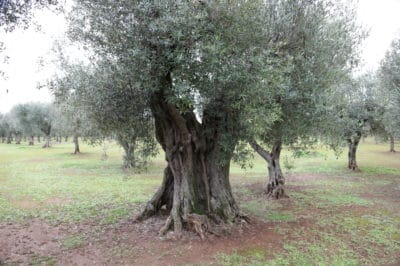What an Olive Tree Looks Like
The useful and beautiful olive tree grows as a small tree or large shrub with oblong, pale, silvery-green leaves measuring 1 ½ to 4 inches (4 to 11 cm) in length. Leaves stay on the tree year-round.
The trunk of these trees often becomes snarled and twisted into interesting shapes as the tree ages, and these trees can live for an astonishing long time with the oldest living specimens being thousands of years old and still producing edible fruit.
Most types of olive tree grow to an ultimate height of about 25 feet (7.6 meters), although some reach as tall as 50 feet (15.25 meters), and some cultivars get taller than others. There are also a few semi-dwarf cultivars which grow to an ultimate height of about 15 feet (4.6 meters), including:
- Arbequina
- Arbosana
- Maurino
The ultimate height of an olive tree is also affected by the quality of soil where it is planted and how much water it receives.
Olive Tree Flowers and Fruits
In spring, olive trees flower, producing small, white groups of blossoms with a feather-like appearance and containing ten calyx and two stamens. The flowers appear in clusters called racemes, growing out of the axils of the leaves.
Most olive varieties are self-fertile, meaning the flowers can pollinate themselves, although when growing olives, better fruit production is often achieved when there are different cultivars planted near one another.
Pollinated flowers turn into olive fruit which is approximately ½ to 1 inch (1.25 to 2.5cm) in length, containing a single, small pit. The fruit starts out green in color and then slowly turns yellow-green then dark purple or black as it ripens.
Olive fruit harvesting happens between October and December, depending on whether the fruit will be cured as green or black table olives or used for oil. Fruits harvested later in the season are generally the ones used for oil because the fruits produce more oil content as they develop.
Planting Zones for Olive Trees
Olive trees, being native to the warmer parts of Europe and the Near East, thrive in USDA planting zones 8 to 11. These temperate climates have mild winters with temperatures staying above 20ºF (-6.6C) and dry, hot summer months. However, olive trees need regular watering during the summer.
